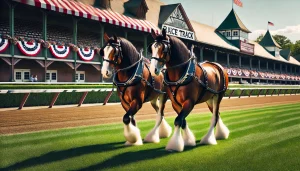
The Saratoga Race Track, nestled in the heart of upstate New York, exudes an aura of timeless elegance and grandeur. The iconic red and white striped awnings and the lush, meticulously maintained grounds set the stage for a scene of unmatched beauty. On this sun-drenched afternoon, two magnificent Clydesdale horses stride together across the track, embodying both power and grace. Their imposing presence is a striking contrast to the lively hum of spectators and the quiet serenity of the natural surroundings.
These Clydesdales, towering over most other breeds, are a sight to behold. Their sturdy frames and muscular build convey a sense of strength that belies their gentle demeanor. The first horse, a dark bay with a gleaming coat that catches the sunlight, walks with a purposeful stride. His mane flows like liquid silk, and his tail sways rhythmically with each step. The signature white feathering on his legs appears almost luminous against the rich earth tones of his coat, a testament to the meticulous care he receives.
Beside him, the second horse, a chestnut beauty, complements her companion with an equally mesmerizing presence. Her coat shines with a coppery brilliance, and her white markings—a broad blaze running down her face and symmetrical stockings—accentuate her elegance. Her movements are fluid and harmonious, each step perfectly in sync with her partner. Together, they form an inseparable pair, their companionship evident in the subtle glances they exchange and the way they mirror each other’s pace.
The Saratoga track itself is a historic gem, steeped in tradition and renowned as one of the oldest thoroughbred racecourses in the United States. The grandstand, with its ornate architecture, stands as a testament to the rich history of horse racing. Today, however, it serves as a backdrop for this extraordinary duo. The spectators, many clad in summer hats and light dresses, pause to admire the Clydesdales as they make their way along the track. Cameras click, capturing moments that will be cherished by all who witness them.
As the horses move, their powerful hooves create a soft, rhythmic beat against the ground, a sound that resonates deeply with those who have come to appreciate the majestic beauty of these animals. Their feathered legs, a distinctive trait of the Clydesdale breed, seem to glide effortlessly, kicking up just enough dust to create a halo-like effect in the afternoon light. The bay horse’s dark coat contrasts beautifully with the chestnut’s warm hues, creating a visual symphony that is both striking and harmonious.
The partnership between these two horses is more than mere companionship; it is a demonstration of trust and mutual respect. Their handlers, walking a few paces behind, observe with quiet pride. These caretakers have dedicated countless hours to grooming, training, and nurturing these animals, ensuring they are both physically and emotionally in peak condition. The bond between horse and human is evident in the way the horses occasionally glance back, their ears twitching in acknowledgment of the reassuring presence of their handlers.
Children in the crowd are especially enchanted by the Clydesdales. Their eyes widen with wonder as they take in the sheer size of the horses, which seem almost otherworldly to them. Some are fortunate enough to get a closer look when the horses pause near the paddock. Here, the chestnut lowers her head gently, allowing a young girl to stroke her velvety nose. The child’s laughter rings out, a pure and joyful sound that seems to heighten the magic of the moment.
These Clydesdales are not just any horses; they are ambassadors of their breed, showcasing the best qualities of strength, gentleness, and intelligence. Originating from Scotland, Clydesdales were initially bred for farm work, their immense strength making them ideal for pulling plows and heavy loads. Over time, they became symbols of nobility and grace, often featured in parades, commercials, and public events. Yet, seeing them in a setting like Saratoga, where the emphasis is usually on speed and agility, offers a unique perspective on their enduring appeal.
As the sun begins to dip lower in the sky, casting a golden glow over the track, the Clydesdales complete their leisurely circuit. The bay horse snorts softly, his breath visible in the cooler evening air. The chestnut shakes her mane, the motion causing her coppery coat to shimmer as if lit from within. Together, they pause for a moment near the finish line, as if reflecting on the journey that has brought them here. The crowd erupts in applause, a spontaneous gesture of appreciation for the beauty and majesty they have just witnessed.
The scene is a poignant reminder of the timeless bond between humans and horses. For centuries, these animals have been our partners in work, war, and leisure. The Clydesdales, in particular, embody a unique combination of power and gentleness, qualities that have endeared them to people around the world. Their presence at Saratoga is not just a spectacle; it is a celebration of this enduring relationship.
As the day draws to a close, the horses are led back to their stables, where they will be carefully tended to. Their handlers will ensure they are groomed, fed, and comfortable, a routine that underscores the deep respect and care these animals inspire. The memory of their walk will linger in the minds of those who witnessed it, a testament to the lasting impact of such moments of natural beauty.
In a world that often feels hurried and disconnected, the sight of two Clydesdale horses walking together at Saratoga Race Track serves as a reminder of the simple joys that can be found in slowing down and appreciating the world around us. Their powerful yet graceful presence, set against the historic charm of Saratoga, creates a tableau that feels almost timeless. It is a moment that speaks to the soul, inviting all who see it to pause, reflect, and find inspiration in the beauty of nature and the enduring spirit of these magnificent animals.